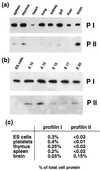Profilin I is essential for cell survival and cell division in early mouse development
- PMID: 11274401
- PMCID: PMC31138
- DOI: 10.1073/pnas.051515498
Profilin I is essential for cell survival and cell division in early mouse development
Abstract
Profilins are thought to play a central role in the regulation of de novo actin assembly by preventing spontaneous actin polymerization through the binding of actin monomers, and the adding of monomeric actin to the barbed actin-filament ends. Other cellular functions of profilin in membrane trafficking and lipid based signaling are also likely. Binding of profilins to signaling molecules such as Arp2/3 complex, Mena, VASP, N-WASP, dynamin I, and others, further implicates profilin and actin as regulators of diverse motile activities. In mouse, two profilins are expressed from two distinct genes. Profilin I is expressed at high levels in all tissues and throughout development, whereas profilin II is expressed in neuronal cells. To examine the function of profilin I in vivo, we generated a null profilin I (pfn1(ko)) allele in mice. Homozygous pfn1(ko/ko) mice are not viable. Pfn1(ko/ko) embryos died as early as the two-cell stage, and no pfn1(ko/ko) blastocysts were detectable. Adult pfn1(ko/wt) mice show a 50% reduction in profilin I expression with no apparent impairment of cell function. However, pfn1(ko/wt) embryos have reduced survival during embryogenesis compared with wild type. Although weakly expressed in early embryos, profilin II cannot compensate for lack of profilin I. Our results indicate that mouse profilin I is an essential protein that has dosage-dependent effects on cell division and survival during embryogenesis.
Figures




References
Publication types
MeSH terms
Substances
LinkOut - more resources
Full Text Sources
Molecular Biology Databases
Research Materials
Miscellaneous

